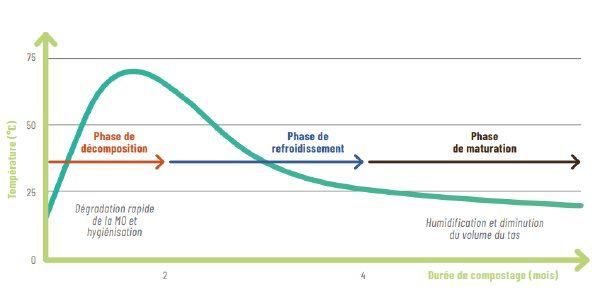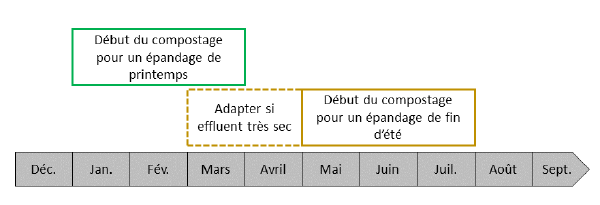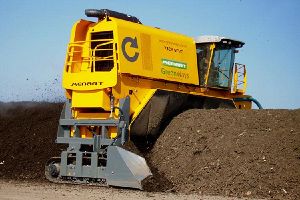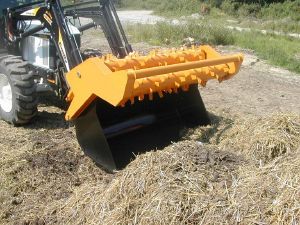
Composting is a process for transforming heterogeneous organic into a homogenous, hygienised product rich in humus and nutrients. All organic waste can be composted (agricultural waste : crop residues, manure or green waste).
The product of composting, compost, is widely used in agriculture because it is easy to spread, has a high concentration of fertilising elements and organic nitrogen (less leachable) and enriches the soil without generating additional costs.
Mechanism and composition
Mechanism
Composting is based on the combined action of various micro-organisms (bacteria and fungi) that break down organic matter. These micro-organisms need oxygen, a temperature maintained between 40 and 60°C and a humidity level between 40 and 60%.
Composting takes place in 2 main stages :

- Decomposition phase : degradation of easily biodegradable organic matter, with an increase in temperature (55-65°C).
- Maturation phase : bacteria and fungi break down recalcitrant organic matter, with a decrease in temperature (25-35°C).
Between these 2 phases, the compost heap gradually cools.
Composition
The composition of compost varies according to the initial effluent, which can be made up of any organic agricultural waste (crop residues, manure, etc.).[2]
- It is advisable to use effluents that are sufficiently straw-like (accumulated litter manure, for example).
- If the effluent is soft and damp (slurry or manure with low straw content), it should be combined with carbon-containing materials (green waste, straw, wood shavings, RCW, etc.).
- If the dry matter content is over 50%, the compost needs to be moistened.
| Type of compost | Total nitrogen
(kg/t) |
P2O5
(kg/t) |
K2O
(kg/t) |
|---|---|---|---|
| Compost
cattle |
6,7 | 3,6 | 10,8 |
| Poultry manure
poultry with litter |
12,2 | 14,3 | 19,3 |
| Compost from
green waste |
10 | 6 | 11 |
It is therefore preferable to use compost on a crop that requires little nitrogen, or as a supplement to a mineral nitrogen fertiliser.
Co-composting
Co-composting is a type of composting based on different types of organic matter, such as manure and plant shreds from waste collection centres. Co-composting has a number of advantages :
- No more organic matter to spread.
- Composting of slurry or manure with a high moisture content thanks to the incorporation of dry waste.
- Contribution ofstructuring elements to the compost.
- Creation of a short supply chain for the management of municipal plant waste, for example.
Anaerobic composting
Anaerobic composting is based on the fermentation of organic compounds by bacteria similar to the lactic bacilli used in cheese-making. In the absence of oxygen, fermentation produces no CO2.
The anaerobic route brings together several composting techniques with different recovery objectives :
- The agricultural methanisation is a system for producing energy (biogas) and fertiliser (digestate). Methanisation is preferable when the objectives are to extend the rotation by introducing CIVEs (Intermediate Crops for Energy Production) and to be self-sufficient in nitrogen while obtaining an additional source of income.
- The Bokashi is a simple Japanese fermentation method that produces a liquid phase (the fermentation juice) rich in nitrogenous matter and a solid phase (the "dry" compost) rich in OM and the micro-organisms necessary for soil fertility. Choosing bokashi is preferable when the waste from the production cycle or the waste collected is diverse and the aim is to have an alternative to artificial nitrogen inputs and to maintain the structure of the soil and its humus.
On-farm composting at the end of the field
Shredding and windrowing
- Choice of plot : load-bearing, not damp and easy to access, soil suitable for spreading.
- The raw material is shredded to a uniform size, neither too fine nor too coarse to facilitate the action of the micro-organisms.
- The material is then placed in piles, known as windrows, to make it easier to turn. Maximum dimensions : 1m80 high, 3m wide.
- Covering to prevent nutrients being washed away by rainfall. It is advisable to use a heavy, permeable geotextile tarpaulin, and to put it in place after the last turning.
Composting start date
The composting period is chosen according to the planned spreading date.[3] :

Composting time
Composting time varies according to how the compost is to be used :
- Less than 2 months : Compost as an organic fertiliser (providing nutrients to plants) with fertilising effects and stimulating soil micro-organisms.
- More than 6 months : Organic amendment type compost (improves the physical, chemical and biological qualities of the soil), enriching the humus content of the soil.
Monitoring composting
Monitoring is necessary to ensure that the composting process runs smoothly. 3 points are essential to the success and production of good compost :
- Temperature : Measured at a depth of around 40 cm, it should be above 50°C. It can be measured directly by hand (if you can't hold your hand there for more than 5 seconds, 50°C has been reached) or using a thermometric probe (around €200). If the temperature is too high, the compost needs to be aerated. If it's too low, the composting process hasn't started, so check the moisture content of the pile.
Aeration : Microorganisms need oxygen to break down organic matter, so the compost heap must be turned at least twice during the composting process. The first turning should take place around 10 days after the pile is placed and the second around 1 month after the first. - Moisture : The compost should be neither too wet nor too dry. A simple handle test can be used to determine the moisture content :

If the mixture is too wet, dry effluent can be added, or the windrow can be turned at a higher frequency to allow the water to evaporate.
If the mixture is too dry, simply water the compost heap.
Over time, the compost will become darker and less fragrant.
Equipment
End-of-field composting requires almost no equipment other than to aerate the compost. Various tools can be used :
- Windrow turner : Fast (10 tonnes/min) but high cost, external service required (around €200 for 2 turnings of 150 tonnes of bovine manure)[3].

- Manure spreader equipped with horizontal hedgehogs : Longer (2 tonnes/min), require 2 tractors (one for the spreader and one for loading).
- Composting bucket.

Using your compost
Incorporation according to crops
Incorporating compost depends on the type of crop :
- Annual crops : Spread before tillage and sowing.
- Perennial crops : Spread before planting or spread between the rows (spread from autumn to spring).
- Meadows : Spread during the grass growth period.
Dosage
Dosage depends on the starting effluent and the type of crop :
- Cattle, sheep and goat compost : 0-15 tonnes/ha for grassland, 15-20 tonnes/ha for cereal crops.
- Poultry compost : highly concentrated composts : no more than 5 tonnes/ha.
Regulations
Regulations depend essentially on the quantity of compost produced.
- Less than 3 tonnes/day : Departmental health regulations.
- More than 3 tonnes/day : ICPE regime (Installation Classée Protection de l'Environnement).
A number of rules need to be taken into account when siting the composting area. The composting area must be located at :
- More than 10 m from roads.
- More than 35 m from watercourses.
- More than 100 m from dwellings (50 m in some cases).
- More than 200 m from swimming areas.
- More than 500 m from fish farms.
Composting is prohibited in flood-prone areas, and the duration of storage and composting must not exceed 10 months. The same composting area may only be re-used after 3 years.
Summary
On-farm composting is easy to implement, requires little equipment and is inexpensive (the cost of a composting site is similar to that of a traditional manure site, around €450 [6]). Composting allows agricultural waste to be recycled and produces a humus and nutrient-rich product that is easy to spread thanks to its homogeneity.
Sources
- ↑ Occitanie Chamber of Agriculture, 2019 : Guide to on-farm composting https://occitanie.chambre-agriculture.fr/fileadmin/user_upload/National/FAL_commun/publications/Occitanie/Agroenvironnement/Guide-compostage-crao2019.pdf
- ↑ Olivier Havard, 2012 : Composting livestock effluent : a technique with convincing advantages https://www.agriculteur-normand.com/le-compostage-des-effluents-delevage-une-technique-aux-atouts-convaincants
- ↑ 3.0 3.1 3.2 Archeagglo, 2015 : A short guide to on-farm composting https://media.archeagglo.fr/filer_public/60/11/6011015e-09d5-401c-a644-fe1f6de1013b/petit_guide_compostage_a_la_ferme_version_maj2017.pdf
- ↑ Valodéa : I install and start my composter https://www.valodea.fr/jeter-moins/le-compostage/dans-mon-jardin/
- ↑ Emily : Compost aerator bucket https://www.emily.fr/nos-produits/godet-aerateur-de-compost/
- ↑ Occitanie Chamber of Agriculture, 2019 : On-farm composting guide https://occitanie.chambre-agriculture.fr/fileadmin/user_upload/National/FAL_commun/publications/Occitanie/Agroenvironnement/Guide-compostage-crao2019.pdf
